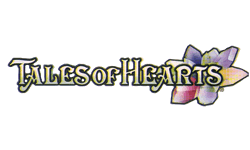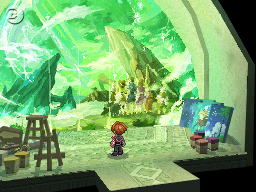|
|

|
PLATFORM
|
DS
|
BATTLE SYSTEM
|

|
INTERACTION
|

|
ORIGINALITY
|

|
STORY
|

|
MUSIC & SOUND
|

|
VISUALS
|

|
CHALLENGE
|
Moderate
|
LANGUAGE BARRIER
|
Moderate
|
COMPLETION TIME
|
20-40 Hours
|
|
OVERALL

|
+ Neat equipment upgrade system.
+ More flashy action in battle.
+ Charming plot and characters.
- Matériel supply issues.
- Lackluster interstitial areas.
|
Click here for scoring definitions
|
|
|
Once upon a time there was a game that began with a fairy tale. It had an emerald-haired princess sleeping in a castle of thorns, and a ruby-haired devil fighting a four-armed demon, a winged whale flying between a moon of purest white and a moon of deepest black. In the grand tradition of such stories, every single one of these things has a basis in truth, but the details are where it gets really interesting. Imperial plots, civil wars, ancient civilizations, planet-eating bioweapons — yes, it sounds like a Tales game.
Tales of Hearts is the third game of its series on the DS, as well as the first on that platform to be developed by the original Tales Studio, and it shows. The missteps of previous games have been largely avoided, and there's a level of polish that helps cover over the flaws that do exist.
As any true Tales game should be, Hearts is practically afloat with proper nouns for concepts that could be explained otherwise. Ethereal, dream-eating monsters called Xerom drain energy from Spiria at the core of human souls, inflicting a cascading emotional disorder known as Despir before turning victims to stone entirely. To combat them, long ago powerful weapons called soma were created, with the ability to dive into the Spirmaze's of people's souls, inspect their Spiria, and destroy whatever Xerom might lurk within.
If none of that made sense, worry not; the game itself does a good job of introducing the concepts and fitting them together right, even if many of the special names are unnecessary fluff. It's enough to understand that in the early scenes, protagonist Kor Meteoryte makes a big mistake in a spirit dive and accidentally fragments fellow protagonist Kohaku Heart's soul into ten pieces, kicking off a metaphysical treasure hunt that spans half the game and most of a continent. Things escalate from there.
The primary strength of the plot is the characterization. The two dozen or so major cast members are well presented in their dialogue, their voice acting, and their game sprite body language. In fact, this game has some of the best sprite work available on the DS, providing full articulation and a broad spectrum of narrative action without polygons or 3D modeling at any point. From body language alone, it is possible to tell how one character feels about another, which is a major point in a game where emotional connections and empathy take center stage as plot elements.
 When in doubt, swing wildly.
When in doubt, swing wildly.
|
|
Likewise, the game's towns and dungeons provide many visual treats, with some areas being wonderfully executed in layout and presentation. On the other hand, the roads linking all of these locations are generic corridors with the occasional open field area. The world map, once it becomes available, is ridiculous in how minimal and spindly its landmasses appear.
Dungeons take a basic puzzle-themed philosophy to their design plan, and while it generally works, it feels like the developers didn't take it far enough. At one point the player is given the Sorcery Ring, which has three major features: the energy shot, to power things up or set them on fire; the kinetic shot, to push or break things; and the energy lash, to pull things to the player (or vice-versa). These three functions are the foundation of most of the game's puzzles, but they could have stood to be unlocked sooner, or to have had more options, or even to have been tied to specific characters, taking advantage of the plot's frequent party splits to grant or block access to some spots. The camera angles used in many dungeons also make it hard to aim the ring properly at times, though that's a minor frustration.
Then there's the other sort of dungeon in this game: the Spirmazes. It's a point of canon that every conscious mind contains one of these, spun out of the ether by the resident soul's emotions, and under certain circumstances animals, monsters, and inanimate objects may have one as well. That said, there's amazingly little variation in how they appear, even with plot-important mazes, as two or three generic designs dominate the visual aesthetic. The only ones with truly unique appearances function as regular dungeons, with none of the extra mechanics found in the mandatory and elective Spirmazes. For the normal sorts, there is a counter that decreases as the player moves around, with the threat of a Game Over if it reaches zero. That is a rare occurrence, as there are several means of recharging the counter, but it adds a sense of urgency as the player rushes through randomly generated sets of corridors with only a minimalistic map to keep track of where they've been
 I'll be honest; Inca Rose looked badass in CGI.
I'll be honest; Inca Rose looked badass in CGI.
|
|
Combat in this game follows the tradtional sideview version of the Tales series' Linear Motion Battle System. The big thing is that it forgoes any version of MP in favor of an energy gauge that sets the limit for how many consecutive attacks the player-controlled character can make. The ally AI is good at serving up the special attacks as well, making most battles fast and flashy. There's also a healing crystal subsystem that can be upgraded and programmed to provide HP recovery and buffs under various conditions, so between that and the healing-intensive characters, it's quite easy to save up all the curative items for the big battles.
The advancement system is an interesting blend of open experience building and gated power limitations. While everyone's health and stats increase with level, the main route to power is to supply their Soma weapons with various materials to activate new passive and active skills, as well as stat boosts across the board. Aside from accessories, there is no other equipment in the game, so properly raising and evolving the Soma is the sole focus for getting stronger. While this is generally well implemented, there are some issues on the matériel side. Specifically, it is not only possible but actually common to gain the potential to learn a skill many hours and dungeons ahead of having access to the necessary items to unlock it. This isn't just a case of 'wait until the next level', but a situation where, ten hours and ten locations later, the player may still not have one specific item, because it simply does not appear before then. In a few other rare circumstances, a skill may require an odd ingredient that has only one source, much earlier in the game, with no ability to backtrack at the time.
One oddity of this game is the fact that it was published in two versions: one with computer-generated video clips and the other with traditional animation. This was an attempt by the company to test the waters, and while traditional animation won out overwhelmingly in the sales consensus (and went on to be the thing used in the Vita remake), the CG material was by no means bad. Totaling four or five videos across the entire game, these clips would have been considered top of the line for the late PSX generation of RPGs, or even the early PS2 era, with a great attention to detail and a strong effort to replicate the appearance of the heroes in 3D. At the same time, this is a Tales game, from a series that is practically defined by its adherence to anime tropes and imagery. For any other game, the CG would have been excellent, but for this one it was simply incongruous. Aside from these video sequences, there is no difference between the two versions. For the record, this review is based on a copy of the CG movie version.
 I don't know art, but I know what I like.
I don't know art, but I know what I like.
|
|
The music in Hearts is the work of Motoi Sakuraba, Hiroshi Tamura, and Hibiki Aoyama, and it serves as an excellent complement to both the gameplay and the video sequences. Much like the locale designs, however, the music possesses a wide range of quality, from strong tracks for the big events to middling stuff that plays throughout the in-between bits. The main theme song, "Eien no Ashita (Eternal Tomorrow)" was performed by the Japanese band Deen, and is a highlight of the soundtrack, even going on to rank in the Japanese Oricon charts for several weeks.
Tales of Hearts isn't the best game of its series, but characterizing it as simply the best on its platform is also damning it with faint praise. This game represents a significant jump in quality from the first of the DS Tales games, as well as an advance in the overall feasibility of expanding the series onto handhelds. It's small wonder that producer Hideo Baba is on record as saying that it was the game he most wanted to share with Western fans, because it does manage to pack a lot of good things into such a small package.
Review Archives
|









